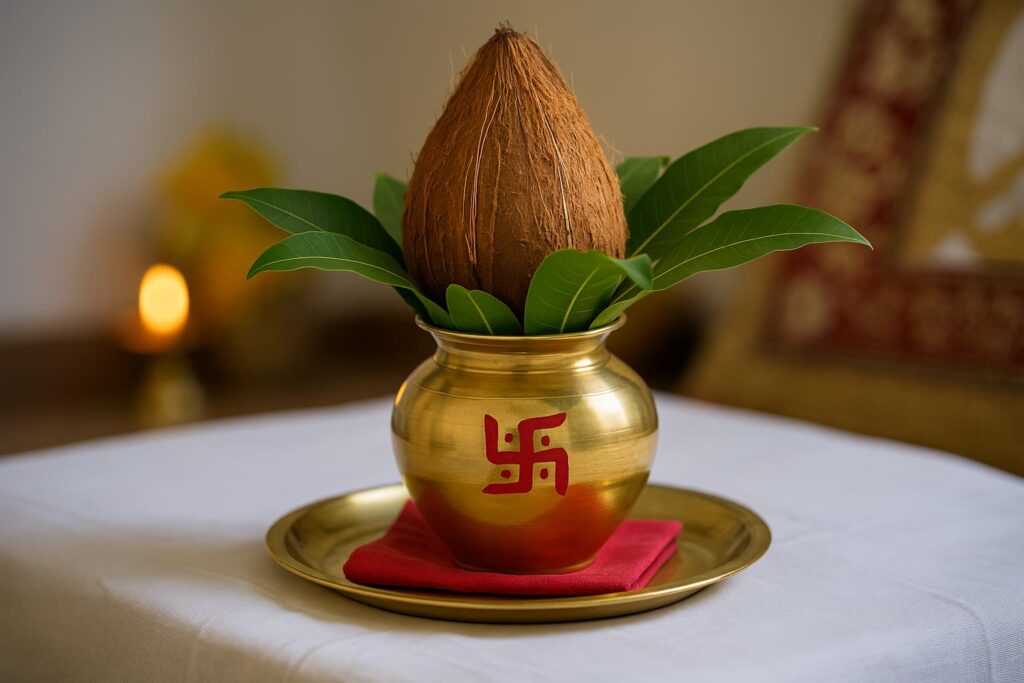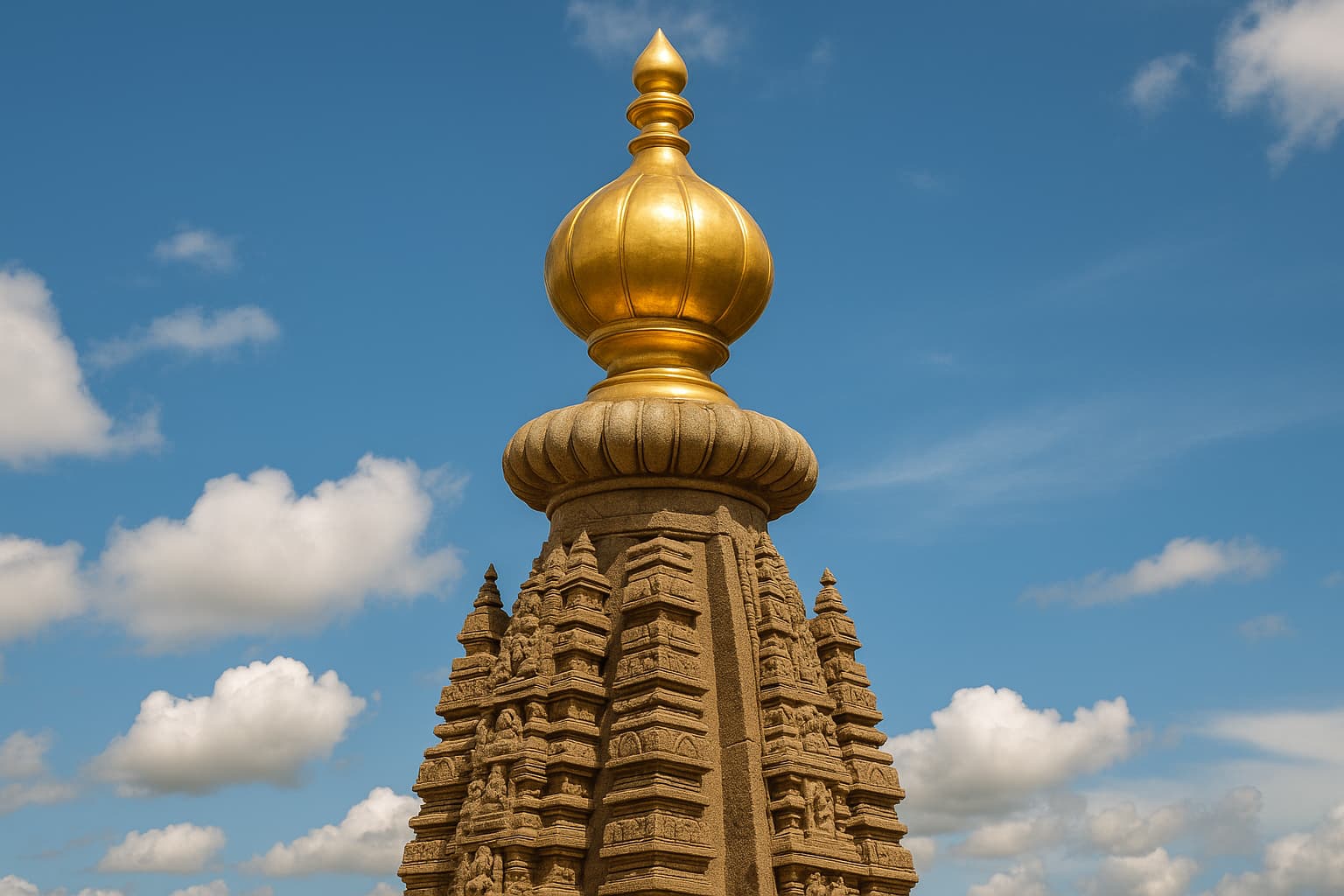The Kalasha on temple tower meaning goes far beyond decoration — it is a symbol of spiritual energy, divine presence, and ancient Vastu principles. When we look up at the tall temple towers of Karnataka, we often see a pot-like structure shining at the top. Many recognize it but don’t fully understand why it’s there. This sacred pot, called the Kalasha, has been part of temple design for centuries, connecting the sky and the sanctum in a deeply symbolic way. In this article, let’s explore what the Kalasha truly represents, why it is placed on the vimana or gopura, and the powerful role it plays in Hindu temple traditions.
🔹 What Is a Kalasha on Temple Towers?
The Kalasha on temple tower is the small pot-like structure you often see right at the top of the temple’s main spire, called the vimana or sometimes on the entrance tower (gopura). It may look simple, but it’s one of the most important symbolic parts of a temple’s design. Usually made of copper, brass, or stone, the Kalasha is believed to hold spiritual energy — like the final point where divine blessings gather.
In Karnataka and other parts of South India, this Kalasha is not just placed casually. It is installed with great care during a special ritual called Kumbhabhishekam, where it is bathed with sacred water, chanted over with mantras, and worshipped before becoming a permanent part of the temple. Once installed, it becomes a kind of spiritual crown for the temple — connecting the heavens with the sanctum below.
🕉️ Symbolic Meaning of the Kalasha
The Kalasha on temple tower meaning is deeply rooted in Indian tradition and spirituality. It may appear like a pot placed at the top, but it actually carries profound symbolism.
The word Purna-Kalasha means “complete pot” — and this completeness stands for prosperity, abundance, and fullness in life. It’s not just about wealth, but also inner peace, purity, and positive energy.
In rituals, a Kalasha is often filled with water (the source of life), topped with mango leaves (symbol of fertility), and a coconut (representing the head or soul). When this same shape is placed on the temple tower, it transforms into a cosmic connector — linking the spiritual energy of the heavens (Brahmanda) with the physical world (Bhooloka).
On a deeper level, the Kalasha also represents Mother Earth — the pot being her body, and the water inside being the life force she holds for all living beings. That’s why it’s always treated with reverence and care, especially in temples.
In short, the Kalasha is not just a decoration — it’s a symbol of wholeness, sacredness, and divine blessing for everyone who enters the temple.

📦 Types of Kalasha Based on Shape & Meaning
Not all Kalashas are the same — temples across India use different shapes and designs, each carrying a unique meaning. Here’s a quick guide to some common types:
| Kalasha Shape | Meaning / Symbolism | Where Commonly Seen |
|---|---|---|
| Round Single-Pot | Symbolizes wholeness, unity, and prosperity | Dharmasthala, simple Dravidian-style temples |
| Pointed Shikhara Kalasha | Represents energy rising toward the divine | Sringeri, Gokarna, Northern Karnataka temples |
| Dome-Shaped (Gola Kalasha) | Symbolizes cosmic womb and fullness | Kukke Subramanya, local village temples |
| Amalaka + Kalasha Combo | Symbolizes spiritual completion and sun-disc energy | Chennakeshava Temple, Belur |
Each Kalasha design is not just architectural — it’s **a spiritual symbol with specific purpose**, energy flow, and local tradition behind it.
🪔 Why Kalasha Is Placed on Top of Temples
Have you ever wondered why temples don’t just end with a flat roof? Why there’s always a shining pot-like structure at the very top? That’s the Kalasha, and it’s not placed there just for decoration — there are strong spiritual and symbolic reasons behind its position.
🌌 Connection to the Cosmos
The Kalasha on temple tower meaning includes its role as a bridge between Earth and the divine. It sits at the highest point of the temple, right above the deity’s sanctum. It is believed that our prayers rise up, and the Kalasha receives blessings from the cosmic realm and redirects them back into the temple — like a spiritual receiver and transmitter.
⚡ Energy Conduction
Just as a lightning rod attracts electrical energy, the Kalasha is said to draw cosmic or divine energy into the temple structure. That energy flows from the top down into the garbha griha (sanctum sanctorum), where the main deity resides. It keeps the temple energetically active, like a sacred power station.
🔺 Sacred Geometry
From an architectural point of view, the Kalasha completes the shape of the temple tower. In yogic terms, the shikhara (temple tower) represents the human spine, and the Kalasha at the top symbolizes the Sahasrara Chakra, or crown chakra — the point of enlightenment and divine connection.
So, the next time you see a Kalasha shining on top of a temple, know that it’s not just a metal pot — it’s a sacred link between the earthly and the divine, helping the temple come alive with spiritual energy.
These four types—Singakalasha, Trikalasha, Matakakalasha, and Golakalasha—are described in traditional temple architecture sources and reflect different symbolic meanings and architectural styles.
🧭 Kalasha in Vastu Shastra
The Kalasha on temple tower is considered a powerful energy tool in Vastu Shastra.
It is usually placed at the Brahmasthana – the central energy point of the temple.
Its main purpose is to attract and amplify cosmic energy from the universe.
Metals like copper, brass, or gold are used because they conduct spiritual vibrations effectively.
The Kalasha acts like a spiritual antenna, pulling in divine energy and guiding it down into the temple.
This helps the garbha griha (sanctum) stay filled with positive energy.
Temples built with proper Vastu and Agama Shastra always focus on the correct placement and ritual installation of the Kalasha.
Once consecrated, the Kalasha becomes a permanent energy center and is rarely ever moved or replaced.
🏛️ Variations of Kalasha in Karnataka Temples
The kalasha on temple tower comes in many styles across Karnataka. While shapes and materials may vary from one temple to another, the spiritual role of the kalasha remains equally important and sacred in each place.
| Temple Name | Kalasha Type | Material Used |
|---|---|---|
| Dharmasthala Manjunatha Temple | Round single-pot | Gold-plated |
| Sringeri Sharada Peetham | Pointed shikhara kalasha | Copper |
| Kukke Subramanya | Simple dome kalasha | Brass |
| Chennakeshava Temple, Belur | Ornamented amalaka + kalasha | Stone + Bronze |
These variations show how temple architecture in Karnataka reflects both beauty and meaning. No matter the style, the Kalasha always remains a sacred symbol of connection between the temple and the divine.

🔍 Rituals and Ceremonial Role
The Kalasha on temple tower is not just placed there as part of construction — it is installed through powerful rituals that carry deep spiritual meaning. During the Kumbhabhishekam (a temple’s re-consecration ceremony), sacred water collected in hundreds of Kalashas is poured over the temple tower, especially the main Kalasha, to purify and energize the structure. Priests chant mantras from ancient scriptures like the Rigveda and Yajurveda, calling upon divine energies to bless the temple. Once the Kalasha is installed on top, it is never touched casually — it is believed to be alive with prana (spiritual life energy) and treated as sacred as the deity itself.
This reverence isn’t limited to large temples alone. In home rituals, a small Kalasha (usually a copper pot filled with water and topped with mango leaves and a coconut) is placed near the deity. It is treated as a mini-temple and symbolizes the divine feminine energy. Whether during Navratri, Satyanarayan Puja, or Vastu Shanti, invoking the Kalasha in rituals is a way of welcoming positive energy, abundance, and divine blessings into the home.
🏠🏛️ Kalasha in Rituals vs Temple Towers
The Kalasha on temple tower and the Kalasha used in home rituals may look similar, but their purpose and energy are quite different. Here’s how they compare:
| Aspect | Kalasha in Home Pujas | Kalasha on Temple Tower |
|---|---|---|
| Purpose | Used to invite divine presence during rituals | Symbolizes permanent divine energy over the temple |
| Placement | Kept near the deity or altar at home | Placed at the top of the vimana or gopura |
| Ritual Use | Used during festivals like Navratri, Satyanarayan Puja | Consecrated during Kumbhabhishekam ceremonies |
| Material | Usually copper, filled with water, mango leaves, coconut | Made of copper, brass, gold, or stone |
| Energy Role | Temporarily holds divine energy for the ritual | Acts as a permanent spiritual antenna for the temple |
Both forms of the Kalasha serve to **connect with the divine**, but one is personal and ritualistic, while the other is architectural and cosmic.
📖 Mythological References
🔱 In the Puranas, the Kalasha is said to have appeared during the Samudra Manthan (churning of the ocean), where it held Amrita, the nectar of immortality.
📜 The Vishwakarma Shilpa Shastra, an ancient guidebook for temple construction, includes references to the Kalasha and its sacred placement in temple architecture.
🐗 In Hindu iconography, Lord Vishnu in his Varaha Avatar is often depicted holding a Kalasha, symbolizing stability, nourishment, and blessings.
🙏 These mythological stories show that the Kalasha is not just a structure — it represents divine energy, eternal prosperity, and cosmic order.
🔬 Scientific Purpose of the Kalasha in Temple Architecture
While the Kalasha on temple tower is a sacred symbol in Hinduism, its placement at the top of temple towers also serves a scientific and architectural purpose. Here’s how tradition aligns with practicality:
- ⚡ Acts as a natural conductor: Kalashas made of copper or brass can help disperse static electricity and protect the temple during lightning strikes.
- 🔊 Enhances temple acoustics: The placement helps reflect and amplify chants and bell sounds, creating a rich spiritual vibration within the temple.
- 🌍 Balances energy flow: As part of traditional Vastu, it connects Earth’s magnetic energy with the cosmic field, especially over the Brahmasthana.
- 🏗️ Architectural finial: Structurally, the Kalasha acts as a capstone that completes the tower and aids in weight distribution and balance.
These points show how temple design beautifully combines spiritual symbolism with practical function — a reminder that ancient architecture was both sacred and scientific.
🧘 Why This Matters for Devotees
🙏 When you look up at the Kalasha on a temple tower, you’re not just seeing a pot — you’re seeing a symbol of divine presence.
🌟 The Kalasha acts like a spiritual anchor, keeping the entire temple energized with positive vibrations and sacred power.
👁️🗨️ Even a simple glance at the Kalasha with faith and devotion is considered a form of symbolic darshan — a spiritual blessing.
🌺 It reminds devotees of wholeness, purity, and prosperity, connecting the soul to the divine without needing to say a word.
The kalasha on temple tower meaning is not just about design or tradition — it’s about connection. This sacred symbol brings together mythology, Vastu, rituals, and energy science into one small yet powerful structure that crowns our temples with divine purpose. Whether made of gold or stone, whether round or pointed, the Kalasha silently reminds us that the divine is always above us, guiding and blessing.
As devotees, understanding the Kalasha helps us see temples not just as buildings, but as living spaces of spiritual energy. The next time you visit a temple and look up at the Kalasha, pause for a moment — and feel that quiet link between the heavens and your heart.

